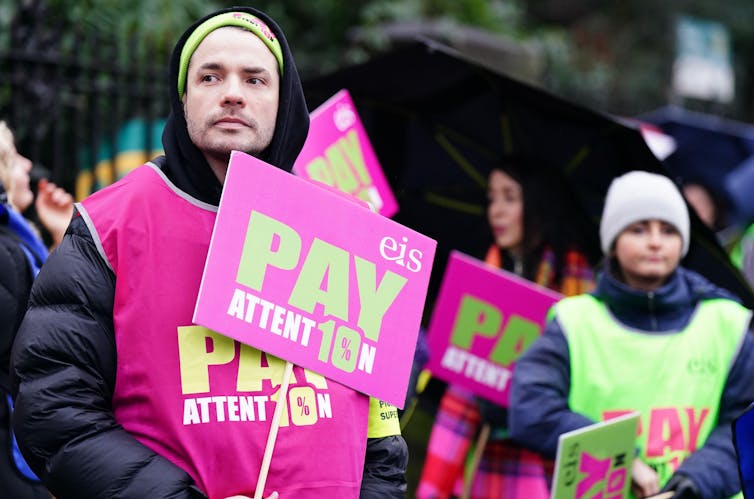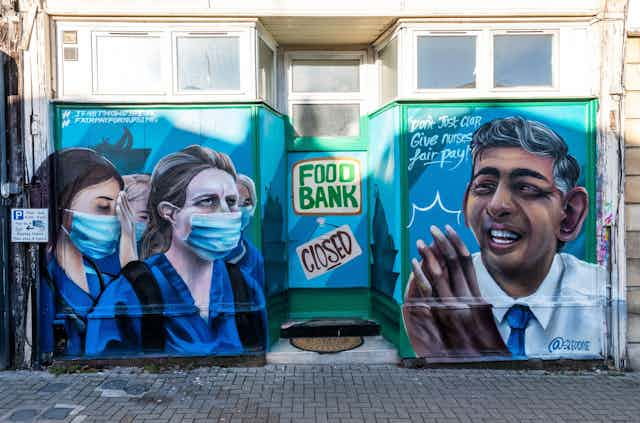Amid ongoing strikes across multiple sectors, Rishi Sunak’s government has announced plans to introduce new legislation that would dramatically tighten restrictions on unions in England, Scotland and Wales.
The strikes (minimum service levels) bill, currently being debated in parliament, would mean that people working in border security, education, the fire brigade, transport, the NHS and nuclear decommissioning would have to maintain minimum levels of service on strike days. So some teachers or nurses, for example, would be expected to work, regardless of whether they are a union member or not.
The language of the bill suggests that sweeping powers will be given to employers to determine what the minimal service level will be on any given strike day, and even who constitutes a key worker and should therefore be required to work. Unions would be expected to ensure their members are meeting these minimal levels of service.
Unions could be taken to court and forced to pay for an employers’ losses caused by strike action. And if a strike compromises the minimum level of service, those continuing to observe the action would be doing so illegally. Someone going on strike would therefore not receive legal protections, such as from being fired, if they went on strike under these conditions. Their employer could consider them in breach of their contract and personally liable.
The definitions given for key workers and minimum service levels in the bill are quite broad, and give employers the ability to decide who and what qualifies. For example, in a hospital, aside from doctors and nurses, cleaning and administration staff could also be declared key workers, and forced to maintain minimal service levels.
There would be nothing to stop a rail company declaring all scheduled services as essential, effectively stopping members from striking at all. As employers get to decide which individual workers they see as vital, they could choose to name union members only, although this may count as trade union victimisation, illegal under the Trade Union and Labour Relations (Consolidation) Act 1992.
The government line
The government says the legislation brings the UK into line with other countries and that it makes sense to promise minimum safety levels in key services during strike action. The bill also suggests that while unions will have a consultative role on who and what constitutes minimum service, the ultimate decision will rest with employers.
Some unions already have voluntary agreements in place with employers to maintain safety. For example, the Royal College of Nursing will offer “derogations” to certain members, effectively giving them permission to continue working to “maintain life preserving care”, with the number of derogations negotiated directly with employers.
The new bill would formalise that negotiation in law – but on terms heavily favouring the employer.
However, there is no law in place to ensure minimum levels of service on non-strike days. This suggests that the aim of the bill is to further restrict trade union power rather than to ensure essential industries continue running or that minimal levels of safety are met.
The government may believe that introducing such restrictions on unions would not only show a tough line on unions by restricting their ability to take disruptive strike action but also show a commitment to the delivery of key services they believe the public consider vital.
This new bill only serves to further worsen employer-union relations. It fails in its wider mission of improving overall service levels, especially on non-strike days. Rather than address union concerns over pay and conditions, it instead seeks to silence them through legal threats.
Raising an already worryingly high bar
Under the current Trade Union Act 2016, unions must already meet certain benchmarks. There must be a 50% turnout in a union’s vote on industrial action for a mandate to strike to be valid, for example.
This effectively weaponises worker indifference. If 49 out of 100 union members voted in favour of a strike, and the other 51 did not show up to vote, then the mandate would not be legal. Thresholds are even higher in “important public services” such as health, education, and transport. Besides achieving a 50% turnout, 40% of eligible voters also need to vote in support of action. So, at least 50 out of 100 would need to vote, and 40 of those 50 would also need to vote in favour.

If passed, this new bill would place an even tighter straitjacket upon unions. Even with a legal mandate to take strike action, employers will have the legal power to determine who counts as a key worker and what constitutes a minimum service.
Despite unions have a consultative role, members and non-members could still be forced to work on strike days, effectively neutralising the mandate and undermining a worker’s right to join a trade union and withdraw their labour. Many will be forced to work, with the threat of dismissal and personal prosecution for failing to do so hanging over them.
Is this what the public wants?
Politically, Sunak’s tough line on unions echoes that of Conservatives dating back to the 1970s. However, the political environment then was different. Research found 80.9% of voters believed unions were too powerful in 1974, declining to 45.5% by 1987.
Similar data from YouGov found that the figure was as low as 25% in December 2021, rising to only 34% in November 2022, even after months of attempts from the government to paint them as such. This suggests that despite Sunak’s efforts to portray unions as out-of-control, voters are not on the same page.

